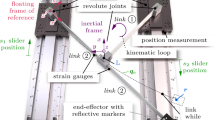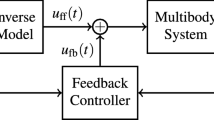Abstract
This work deals with modeling and tracking of mechanical systems which are given as kinematic chains with restricted degrees of freedom. Such systems may involve many joints, but due to additional restrictions or mechanical properties the joints depend on each other. So-called closed-chain or parallel manipulators are examples for kinematic chains with additional constraints. Though the degrees of freedom are limited, the complexity of the dynamic equations increases rapidly when studied analytically. In this work, we suggest to avoid this kind of analytic integration of interconnection constraints and instead to model them numerically via soft constraints.
Preview
Unable to display preview. Download preview PDF.
Similar content being viewed by others
References
Bicchi, A., Prattichizzo, D.: On some structural properties of general manipulation systems. In: Astolfi, A., et al. (eds.) Modelling and Control of Mechanichal Systems, pp. 187–202. Imperial College Press, London, U.K (1997)
Blaschke, W.: Kinematik und Quaternionen, Mathematische Monographien, Deutscher Verlag der Wissenschaften, vol. 4 (1960)
Bregler, C., Malik, J.: Tracking people with twists and exponential maps. In: Proc. Computer Vision and Pattern Recognition, Santa Barbara, California, pp. 8–15 (1998)
Bregler, C., Malik, J., Pullen, K.: Twist based acquisition and tracking of animal and human kinetics. International Journal of Computer Vision 56(3), 179–194 (2004)
Carranza, J., et al.: Free-viewpoint video of human actors. In: Proc. SIGGRAPH 2003, pp. 569–577 (2003)
Chan, T., Vese, L.: Active contours without edges. IEEE Transactions on Image Processing 10(2), 266–277 (2001)
Cheng, H., Yiu, Y.: Dynamics and control of redundantly actuated parallel manipulators. Trans. on Mechatronics 8(4), 483–491 (2003)
Denavit, J., Hartenberg, R.S.: A kinematic notation for lower-pair mechanisms based on matrices. ASME Journal of Applied Mechanics 22, 215–221 (1955)
Fua, P., Plänkers, R., Thalmann, D.: Tracking and modeling people in video sequences. Computer Vision and Image Understanding 81(3), 285–302 (2001)
Gao, X., Qu, Z.: On the robust control of two manipulators holding a rigid object. Intelligent and Robotic Systems 8, 107–119 (1992)
Gavrila, D.M.: The visual analysis of human movement: A survey. Computer Vision and Image Understanding 73(1), 82–92 (1999)
Kim, D., Kang, J., Lee, K.: Robust tracking control design for a 6 dof parallel manipulator. Journal of Robotics Systems 17(10), 527–547 (2000)
Mikic, I., et al.: Human body model acquisition and tracking using voxel data. International Journal of Computer Vision 53(3), 199–223 (2003)
Moeslund, T.B., Hilton, A., Krüger, V.: A survey of advances in vision-based human motion capture and analysis. Computer Vision and Image Understanding 104(2), 90–126 (2006)
Moeslund, T.B., Granum, E.: A survey of computer vision based human motion capture. Computer Vision and Image Understanding 81(3), 231–268 (2001)
Murray, R.M., Li, Z., Sastry, S.S.: Mathematical Introduction to Robotic Manipulation. CRC Press, Baton Rouge (1994)
Ostrowski, J.: Computing reduced equations for robotic systems with constraints and symmetries. Trans. on Robotics and Automation 15(1), 111–123 (1999)
Rosenhahn, B.: Pose estimation revisited. Technical Report TR-0308, PhD-thesis, Institute of Computer Science, University of Kiel, Germany (October 2003), http://www.ks.informatik.uni-kiel.de
Rosenhahn, B., Brox, T., Weickert, J.: Three-dimensional shape knowledge for joint image segmentation and pose tracking. International Journal of Computer Vision 73(3), 243–262 (2007)
Zweiri, Y., Senevirante, L., Althoefer, K.: Modelling of closed-chain manipulators on an excavator vehicle. Mathematical and Computer Modeling of Dynamical Systems 12(4), 329–345 (2003)
Author information
Authors and Affiliations
Editor information
Rights and permissions
Copyright information
© 2008 Springer-Verlag Berlin Heidelberg
About this paper
Cite this paper
Rosenhahn, B., Brox, T., Cremers, D., Seidel, H.P. (2008). Modeling and Tracking Line-Constrained Mechanical Systems. In: Sommer, G., Klette, R. (eds) Robot Vision. RobVis 2008. Lecture Notes in Computer Science, vol 4931. Springer, Berlin, Heidelberg. https://doi.org/10.1007/978-3-540-78157-8_8
Download citation
DOI: https://doi.org/10.1007/978-3-540-78157-8_8
Publisher Name: Springer, Berlin, Heidelberg
Print ISBN: 978-3-540-78156-1
Online ISBN: 978-3-540-78157-8
eBook Packages: Computer ScienceComputer Science (R0)




